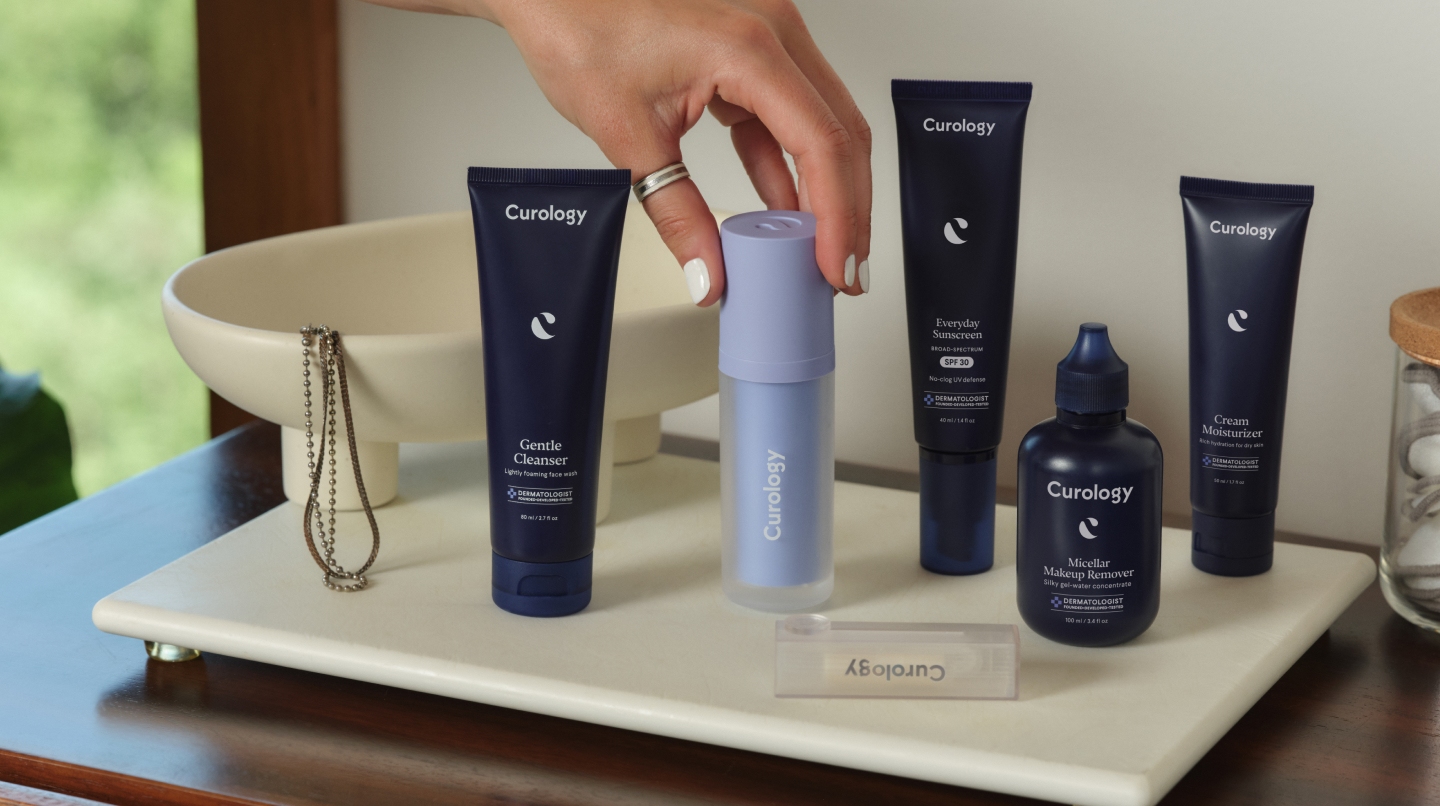How it works:
Share your skin goals and snap selfies
Your dermatology provider prescribes your formula
Apply nightly for happy, healthy skin
How it works:
How it works:
Share your skin goals and snap selfies
Your dermatology provider prescribes your formula
Apply nightly for happy, healthy skin
How it works:
Tretinoin
Use tretinoin to send acne packing and turn back the clock!



Tretinoin is well-known in the skincare industry for its anti-aging and acne properties—it’s considered by some to be the gold standard for acne. The only major catch? It can take some time for your skin to adjust to tretinoin, during which you may experience increased breakouts, redness, or irritation.
Here we’ll explain this powerful ingredient, how it works, and how to use it in your skincare routine. We’ll also highlight which skincare ingredients to avoid while you’re using tretinoin and which work well with it so that you can begin noticing improvements as quickly and easily as possible.
What is tretinoin?
Tretinoin (Retin-A, retinoic acid) is a prescription-strength ingredient in the same family as over-the-counter retinol. Both are vitamin A derivatives that stimulate skin cell turnover and increase collagen production¹—a protein that helps build the skin’s framework. While both help boost skin firmness, reduce the appearance of wrinkles and facilitate new skin cell growth, only tretinoin is approved by the FDA to treat the signs of aging and acne.
Available as a gel, lotion, or cream, tretinoin helps improve elasticity, reduce hyperpigmentation, even skin texture and tone, and clear clogged pores. Unlike retinol, which needs to be converted into retinoic acid before it starts to work,² tretinoin interacts with your skin immediately, so it can deliver results more quickly.
What does tretinoin do?
Tretinoin has a proven track record—it’s been used for more than 40 years to treat signs of aging and acne. Tretinoin reduces the appearance of fine lines and wrinkles by boosting collagen production, and it improves skin tone and texture by accelerating the natural skin cell cycle.³ When it comes to treating acne, tretinoin helps prevent clogged pores and boosts collagen production to help reduce the appearance of acne scarring.⁴
What are the benefits of tretinoin?
Skin naturally sheds dead cells and replaces them with new, healthy ones. When this gets out of whack, acne or other skin concerns can occur, but tretinoin works on a cellular level to restore the skin’s turnover process.
Here’s what you need to know about the benefits of tretinoin cream use:⁵
Helps clear out dead skin cells. Tretinoin normalizes the cell regeneration process to clear out dead skin cells and help prevent clogged pores.
Reduces inflammation. Inflammation occurs in the skin through complex biological pathways. Tretinoin blocks those pathways—it blocks the process from occurring, which reduces inflammation associated with acne.
Stimulates collagen production. Collagen forms in the deeper skin layers (dermis). Acne scars form when there’s an imbalance of collagen production in the dermis. Tretinoin boosts collagen production, which can reduce scarring and improve overall skin texture.
Improves skin pigmentation. Tretinoin accelerates skin cell turnover on the skin’s surface. This process improves hyperpigmentation and evens skin tone. Studies show retinoids are effective in treating acne-related post-inflammatory hyperpigmentation.
What are the potential side effects of tretinoin?
Tretinoin is really good at doing its job and goes to work right away. Because of this, some people experience an adjustment period during which the skin may get worse before it gets better. You might hear the term “skin purging” to describe this process.
This process may lead to some potential side effects, but don’t worry. It means it’s working. Here are some potential side effects you may experience when getting started with tretinoin:
Increased UV sensitivity. Tretinoin can increase the skin’s sensitivity to the sun.⁶ That’s why it’s better to use tretinoin at night and always apply a broad-spectrum sunscreen with at least SPF 30 during the day (which you should be doing anyway!).
Increased dryness and flaking of the skin.⁷ As the process begins, you may experience burning, stinging, itching, or flaking, especially if you have dry or sensitive skin. The process is typically temporary, but you can help your skin by applying a rich moisturizer.
Increased breakouts. Getting started with tretinoin sometimes comes with a price—more pimples! Accelerating the skin cell turnover process can lead to blocked pores and irritation to the skin’s surface, potentially leading to breakouts. This is part of the purging process, and again, it’s temporary.

How to use tretinoin
“Slow and steady” is the name of the game when getting started with tretinoin. Apply it just two to three nights during the first one to two weeks. Once your skin adjusts, apply every other night for a couple of weeks before upping your use to every night. By the end of five to six weeks, you’ll be using your treatment cream nightly.
Here’s how to incorporate tretinoin into your skincare routine:
Cleanse. Apply tretinoin to clean the skin. Splash your face with lukewarm water before using a cleanser. Rinse and pat dry with a soft cloth.
Apply. Use at night and apply tretinoin to a fully dry face. Damp skin may absorb tretinoin more quickly. That’s not necessarily a bad thing, but it can increase sensitivity during the adjustment period.
Moisturize. Allow tretinoin to absorb before applying your moisturizer. Look for hydrating ingredients like hyaluronic acid, glycerin, and shea butter..
Use sunscreen. When using tretinoin, it’s especially important to apply sunscreen daily. Use broad-spectrum sunscreen with at least SPF 30 each morning and reapply throughout the day. Here are some pro tips for using sunscreen.
If your skin is having a hard time during the adjustment period, use your moisturizer first or dilute your tretinoin cream 50/50 with moisturizer before applying it to your skin. Neither of these tricks will render tretinoin any less effective.
For optimal results, be sure to read up on these simple waxing recommendations when using tretinoin.
Other ingredients that work well with tretinoin
Tretinoin plays well with others—but you should typically avoid active ingredients such as salicylic acid and benzoyl peroxide during the adjustment period. Once your skin adjusts, you may find that tretinoin is all you need to treat your acne and anti-aging concerns.
Another ingredient to consider stopping during the 5-6 week adjustment period is vitamin C. However, you may choose to include vitamin C once your skin is used to using tretinoin. Vitamin C is one of the best antioxidants to protect against photoaging from the sun. It’s a powerful antioxidant that reduces inflammation, boosts collagen, and improves skin tone.⁸
Here are some other ingredients worth considering—they are generally safe to use with tretinoin and, depending on your skin, maybe that extra punch it needs.
Niacinamide has anti-inflammatory and antioxidant properties. It improves hydration, boosts collagen, fades hyperpigmentation, and evens skin tone.⁹
Hyaluronic acid is a humectant—it draws moisture to the epidermis (outer skin layer) to boost hydration. Hyaluronic acid binds to water molecules to retain moisture.¹⁰
Azelaic acid is used to treat rosacea, fade dark spots, and reduce breakouts.¹¹
Clindamycin is an antibiotic that prevents the spread of acne-causing bacteria.¹² It also has anti-inflammatory properties to reduce pain and swelling associated with breakouts.¹³
FAQs
Tretinoin (Retin-A, retinoic acid) is a prescription-strength ingredient in the same family as over-the-counter retinol. Both are vitamin A derivatives that stimulate skin cell turnover and increase collagen production—a protein that helps build the skin’s framework.
Tretinoin has a proven track record—it’s been used for more than 40 years to treat signs of aging and acne. Tretinoin reduces the appearance of fine lines and wrinkles by boosting collagen production, and it improves skin tone and texture by accelerating the natural skin cell cycle.
Here’s what you need to know about the benefits of tretinoin cream use:
Helps clear out dead skin cells. Tretinoin normalizes the cell regeneration process to clear out dead skin cells and help prevent clogged pores.
Reduces inflammation. Inflammation occurs in the skin through complex biological pathways.
Stimulates collagen production. Collagen forms in the deeper skin layers (dermis). Acne scars form when there’s an imbalance of collagen production in the dermis.
Improves skin pigmentation. Tretinoin accelerates skin cell turnover on the skin’s surface. This process improves hyperpigmentation and evens skin tone.
P.S. We did the homework so you don’t have to:
Harvard Health Publishing. Do retinoids really reduce wrinkles? (2022).
Mukherjee S, et al. Retinoids in the treatment of skin aging: an overview of clinical efficacy and safety. Clin Interv Aging. (2006 December).
Baldwin, H.E., et al. 40 Years of topical tretinoin use in review.Journal of Drugs in Dermatology. (2013).
Leyden, J., et al. Why topical retinoids are mainstay of therapy for acne.Dermatology and Therapy. (September 2017).
Leyden, J., et al. Why topical retinoids are mainstay of therapy for acne.Dermatology and Therapy. Ibid.
Mukherjee, S., et al. Retinoids in the treatment of skin aging: an overview of clinical efficacy and safety.Clinical interventions in aging. Ibid.
Baldwin, H.E., et al. 40 Years of topical tretinoin use in review.Journal of Drugs in Dermatology. (Ibid).
Pullar, J.M., et al. The roles of vitamin C in skin health.Nutrients. (August 2017).
Vlase, L., et al. Mechanistic basis and clinical evidence for the applications of nicotinamide (niacinamide) to control skin aging and pigmentation. Antioxidants. (August 2021).
Sudha, P.N. and Rose, M.H. Chapter Nine - Beneficial effects of hyaluronic acid. Advances in Food and Nutrition Research. (2014).
Schulte, B. C., et al.Azelaic Acid: Evidence-based Update on Mechanism of Action and Clinical Application.Journal of Drugs in Dermatology. (2015).
Murphy, P.B., et al. Clindamycin. StatPearls. (2022 June 17).
James Q. Del Rosso, DO; Nicholas F. Schmidt, PhD. A Review of the Anti-inflammatory Properties of Clindamycin in the Treatment of Acne Vulgaris.Drug Therapy Topics. (January 2010).
Kristen Jokela is a certified Family Nurse Practitioner at Curology. She obtained her Master of Science in Nursing at the University of South Florida in Tampa, FL.
* Subject to consultation. Subscription is required. Results may vary.

Curology Team

Kristen Jokela, NP-C
Related Articles
How to remove makeup without makeup remover wipesThe complete guide to face cleansers for every skin typeSkincare tips for dry skin, according to dermatology providers5 ways to calm sensitive skin, according to dermatology expertsThe 6 best chemical exfoliators for glowing skinPopular Articles
Ask Curology: Is my cold breaking me out?Slugging: The dermatologist-approved skincare hack going viral on TikTokTretinoin vs retinol: What’s the difference?How to create a self-care routine that actually sticksYour 2023 skincare horoscopeTry prescription skincare
Get routine essentials

Good skin days ahead
- Breakouts
- Redness
- Fine lines
- Dark spots
- Hair thinning